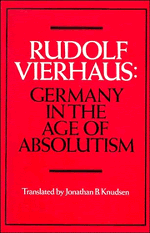Introduction: Germany after the Thirty Years War
Published online by Cambridge University Press: 05 June 2012
Summary
SOCIOECONOMIC CONSEQUENCES: COLLAPSE AND DELAYED DEVELOPMENT
“I do not intend to give the reader of this history, as it is often done, a mosaic constructed from an infinite number of individual accounts. [This method] perhaps aims more to arouse terror and compassion than to bring about a creative synthesis and inner understanding,” wrote Bernhard Erdmannsdorffer. He was seeking to reconstruct the “material and cultural conditions” after the Thirty Years War in his still valuable German History from the Westphalian Peace to the Accession of Friedrich the Great (1882). He thought that such a synthesis was not yet possible, though “the new research in economic history” might one day make it so. Since then we have learned much more, but we still cannot give a general account of the war's consequences that is complete in detail and breadth.
The contemporary reports of the devastations of the Thirty Years War, and the accounts in the imaginative literature do not always rest on direct experience. If some of these works do not reveal the extent of the suffering caused by the war, others exaggerate. More importantly, the devastations were not spread equally throughout Germany. The war spared extensive areas largely or completely; in others, it passed through numerous times, bringing with it destruction, plunder, and impoverishment.
- Type
- Chapter
- Information
- Germany in the Age of Absolutism , pp. 1 - 11Publisher: Cambridge University PressPrint publication year: 1989



